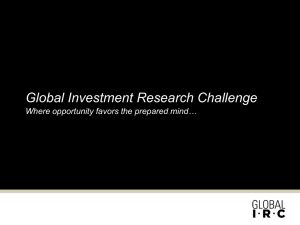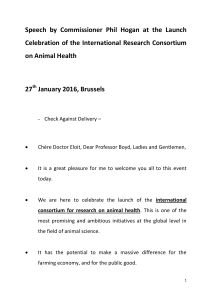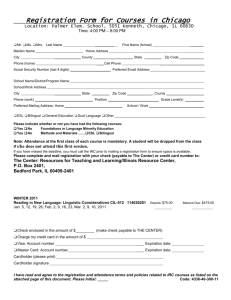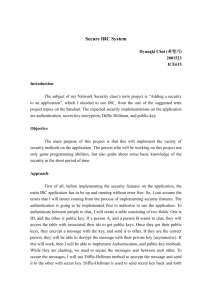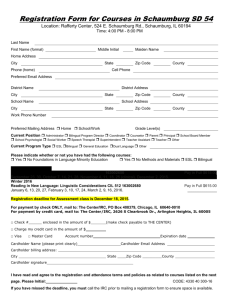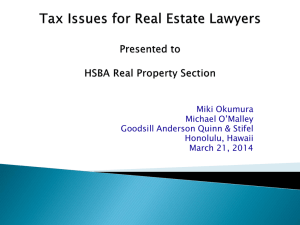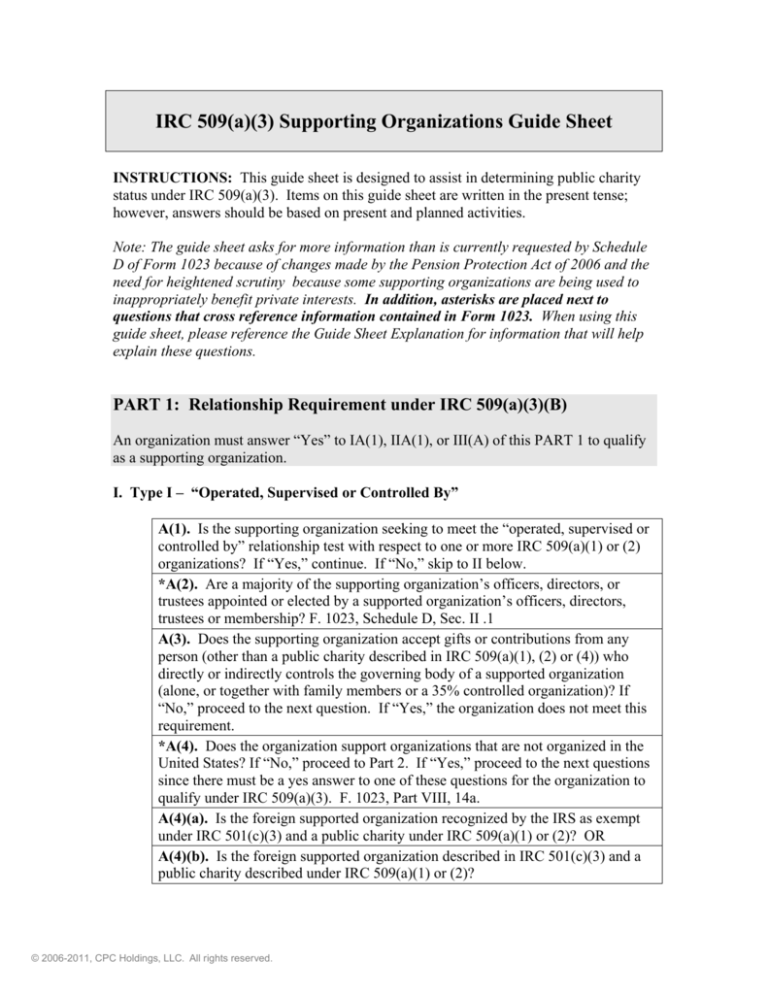
IRC 509(a)(3) Supporting Organizations Guide Sheet
INSTRUCTIONS: This guide sheet is designed to assist in determining public charity
status under IRC 509(a)(3). Items on this guide sheet are written in the present tense;
however, answers should be based on present and planned activities.
Note: The guide sheet asks for more information than is currently requested by Schedule
D of Form 1023 because of changes made by the Pension Protection Act of 2006 and the
need for heightened scrutiny because some supporting organizations are being used to
inappropriately benefit private interests. In addition, asterisks are placed next to
questions that cross reference information contained in Form 1023. When using this
guide sheet, please reference the Guide Sheet Explanation for information that will help
explain these questions.
PART 1: Relationship Requirement under IRC 509(a)(3)(B)
An organization must answer “Yes” to IA(1), IIA(1), or III(A) of this PART 1 to qualify
as a supporting organization.
I. Type I – “Operated, Supervised or Controlled By”
A(1). Is the supporting organization seeking to meet the “operated, supervised or
controlled by” relationship test with respect to one or more IRC 509(a)(1) or (2)
organizations? If “Yes,” continue. If “No,” skip to II below.
*A(2). Are a majority of the supporting organization’s officers, directors, or
trustees appointed or elected by a supported organization’s officers, directors,
trustees or membership? F. 1023, Schedule D, Sec. II .1
A(3). Does the supporting organization accept gifts or contributions from any
person (other than a public charity described in IRC 509(a)(1), (2) or (4)) who
directly or indirectly controls the governing body of a supported organization
(alone, or together with family members or a 35% controlled organization)? If
“No,” proceed to the next question. If “Yes,” the organization does not meet this
requirement.
*A(4). Does the organization support organizations that are not organized in the
United States? If “No,” proceed to Part 2. If “Yes,” proceed to the next questions
since there must be a yes answer to one of these questions for the organization to
qualify under IRC 509(a)(3). F. 1023, Part VIII, 14a.
A(4)(a). Is the foreign supported organization recognized by the IRS as exempt
under IRC 501(c)(3) and a public charity under IRC 509(a)(1) or (2)? OR
A(4)(b). Is the foreign supported organization described in IRC 501(c)(3) and a
public charity described under IRC 509(a)(1) or (2)?
© 2006-2011, CPC Holdings, LLC. All rights reserved.
2
II. Type II – “Supervised or Controlled in Connection With”
A(1). Is the organization seeking to meet the “supervised or controlled in
connection with” relationship test with respect to one or more IRC 509(a)(1) or
(2) organizations? If “Yes,” continue. If “No,” skip to III below.
*A(2). Is control or management of the supporting organization placed with the
same persons that control or manage the supported organization? F. 1023,
Schedule D, Sec. II.2
*A(3). Does the organization support organizations that are not organized in the
United States? If “No,” proceed to Part 2. If “Yes,” proceed to the next questions
since there must be a yes answer to one of these questions for the organization to
qualify under IRC 509(a)(3). F. 1023, Part VIII, 14a.
A(3)(a). Is the foreign supported organization recognized by the IRS as exempt
under IRC 501(c)(3) and a public charity under IRC 509(a)(1) or (2)? OR
A(3)(b). Is the foreign supported organization described in IRC 501(c)(3) and a
public charity described under IRC 509(a)(1) or (2)?
III. Type III – “Operated in Connection With”
A(1) Is the organization seeking to meet the “operated in connection with”
relationship test with respect to one or more IRC 509(a)(1) or (2) organizations?
If “No,” stop and see the Guide Sheet Explanation. If “Yes,” continue. To
qualify, an organization must meet the requirements under A(2), A(3), B(1) and
B(2).
A(2) Does the supporting organization accept gifts or contributions from any
person (other than a public charity described in IRC 509(a)(1), (2) or (4)) who
directly or indirectly controls the governing body of a supported organization
(alone, or together with family members or a 35% controlled organization)? If
“No,” proceed to the next question. If “Yes,” the organization does not meet this
requirement.
*A(3) Does the organization support organizations that are not organized in the
United States? If “No,” proceed to Part 2. If “Yes,” the organization does not
meet this requirement unless it meets a transition rule. See the Guide Sheet
Explanation for the transition rule. F. 1023, Part VIII.14a.
*B(1). Does the organization meet the responsiveness test? For trusts in
existence prior to August 17, 2006, see the Guide Sheet Explanation for a
description of the alternative responsiveness test. To qualify there must be a
“Yes” answer to questions (a), (b) or (c) plus a “Yes” answer to question (d). F.
1023, Schedule D, Section II.4. a-d.
(a). Do the officers, directors, trustees, or membership of the supported
organization(s) elect or appoint one or more of the supporting organization’s
officers, directors, or trustees? F. 1023, Schedule D, Section II.4.a
© 2006-2011, CPC Holdings, LLC. All rights reserved.
3
(b). Are one or more members of the governing bodies of the supporting
organization also officers, directors, or trustees or hold other important offices in
the supported organization(s)? F. 1023, Schedule D, Section II.4.b
(c). Do the officers, directors, or trustees of the supporting organization maintain
a close and continuous working relationship with the officers, directors, or
trustees of the supported organization(s)? F. 1023, Schedule D, Section II.4.c
(d). By reason of the relationship described above in (a), (b) or (c), does the
supported organization(s) have a significant voice in the supporting organization’s
investment policies, the timing of grants, the manner of making grants, or the
selection of recipients of grants? F. 1023, Schedule D, Section II.4.d
B(2). Does the organization meet the integral part test?
To qualify, a Type III supporting organization that is not functionally integrated
must meet the requirements under question B(2)(a), and a functionally integrated
Type III organization must meet the requirements under question B(2)(b).
B(2)(a). Is the organization seeking to be a Type III supporting organization that
is not functionally integrated? If “Yes,” there must be “Yes” answers to
B(2)(a)(i) and B(2)(a)(ii).
*B(2)(a)(i). The Payout Requirement
Does the supporting organization pay substantially all (85%) of its adjusted net
income to or for the use of the supported organization(s)? If “Yes,” go to
B(2)(a)(ii). If “No,” the organization does not meet the payout requirement. F.
1023, Schedule D, Section II.6.a.
B(2)(a)(ii). The Attentiveness Requirement
The answer must be “Yes” to Cluster 1, Cluster 2, Cluster 3, or Cluster 4.
Cluster 1
To meet Cluster 1, the answers must be “Yes” to (a) and (b).
(a). Is the payout to one or more of the supported organizations large enough to ensure
the attentiveness of the organization(s) to the operations of the supporting organization
(equals 10% or more of the supported organization’s (1) total support for the year, or (2)
support for the year received by a department where the supported organization is a
school, hospital, or church)?
(b). Does a substantial amount of the supporting organization’s total support (one-third
of the supporting organization’s income for the year) go to those publicly supported
organizations that meet the attentiveness requirement described in (a) above?
© 2006-2011, CPC Holdings, LLC. All rights reserved.
4
Cluster 2
To meet Cluster 2, the answers must be “Yes” to (a) through (e).
(a). Are the payments sufficiently significant to ensure the attentiveness of the supported
organization(s) because they are earmarked for a particular substantial program or
activity of the supported organization(s) that would not exist or would be interrupted
without the payment?
(b). Does the supporting organization provide 50% or more of the funding of the
earmarked program or activity?
(c). Is the supporting organization funding the same earmarked program continuously
year after year?
(d). Is the earmarked program a substantial program?
(e). Does a substantial amount of the supporting organization’s total support (one-third
of the supporting organization’s income for the year) go to those publicly supported
organizations that meet this earmarked attentiveness requirement?
Cluster 3
To meet Cluster 3, the answer must be “Yes” to (a).
(a). Is the supported organization(s)’ attentive to the supporting organization based on all
the pertinent facts and circumstances, including the length and nature of the relationship;
the number of other supported organizations; the percentage of support contributed by the
supported organization to the supporting organization’s total support; evidence of actual
attentiveness; and a substantial identity of interests between the two organizations?
Cluster 4
To meet Cluster 4, the answers must be “Yes” to (a) or (b) and to (c) through (e).
(a). Is the supporting organization a charitable trust described in IRC 4947(a)(1) that was
created before November 20, 1970?
(b). Was the supporting organization an irrevocable split-interest trust that was described
in IRC 4947(a)(2) on November 20, 1970, and that subsequently became a charitable
trust described in IRC 4947(a)(1)?
(c). Is all of the supporting organization’s net income used to benefit the supported
organization(s)?
(d). Are the supporting organization’s trustees prohibited from having a right to vary
beneficiaries or amounts?
(e). Are disqualified persons described in IRC 4946 with respect to the supporting
organization prohibited from serving as trustees?
© 2006-2011, CPC Holdings, LLC. All rights reserved.
5
B(2)(b). Functionally Integrated Type III Supporting Organization
Is the organization seeking to be classified as a functionally integrated Type III
supporting organization? If “Yes,” see the Guide Sheet Explanation.
PART 2: Organizational Test under IRC 509(a)(3)(A)
An organization must meet the organizational test to qualify under IRC 509(a)(3). If a
supporting organization does not meet either I or II, it is not qualified under IRC
509(a)(3). Special organizational test rules pertain to supporting organizations that
support IRC 501(c)(4), (5) or (6) organizations. Therefore, complete PART 5 rather than
this PART 2 to demonstrate that an organization meets the organizational test where it
seeks to qualify under IRC 509(a)(3) because it is supporting an IRC 501(c)(4), (5) or (6)
organization.
I. Organizational Test for a Type I or II Supporting Organization
A. Is the supporting organization requesting classification as a Type I or II
supporting organization? If “Yes,” to satisfy the organizational test there must be
a yes answer to one of the questions B, C or D below. In addition, all three
components of question E must be met.
*B. Does the supporting organization’s organizing document specify by name the
IRC 509(a)(1) or (2) organization(s) it supports? If “Yes,” skip to E below. F.
1023, Schedule D, Section III.1.a OR,
*C. Does the supporting organization’s organizing document identify the IRC
509(a)(1) or (2) organization(s) it supports by class or purpose? If “Yes,” skip to
E below. F. 1023, Schedule D, Section III.1.a
D. Do the supporting organization and the supported organization(s) have a
historic and continuing relationship such that there is a substantial identity of
interests between the two organizations?
E. To meet the organizational test, there must be a “Yes” answer to E(1) and
“No” answers to E(2) and E(3).
E(1). Does the organization’s organizing document limit its purposes to
provide that it is organized, and at all times thereafter is operated
exclusively for the benefit of, to perform the functions of, or to carry out
the purposes of one or more specified 509(a)(1) or (a)(2) organizations?
E(2). Does the organization’s organizing document expressly empower it
to engage in activities which are not in furtherance of the purposes stated
in (E)(1) above?
E(3). Does the organization’s organizing document expressly empower it
to operate to support or benefit any organization not specified by name,
purpose, or class in its organizing document?
© 2006-2011, CPC Holdings, LLC. All rights reserved.
6
II. Organizational Test for a Type III Supporting Organization
A. Is the supporting organization requesting classification as a Type III supporting
organization? If “Yes,” there must be a yes answer to either question B or C
below. In addition, all three components of question D must be met.
*B. Does the supporting organization’s organizing document specify by name the
IRC 509(a)(1) or (a)(2) organization(s) it supports? F. 1023, Schedule D, Section
III.1.b
C. Do the supporting organization and the supported organization(s) have a
historic and continuing relationship such that there is a substantial identity of
interests between the two organizations?
D. To meet the organizational test, there must be a “Yes” answer to D(1) and
“No” answers to D(2) and D(3).
D(1). Does the organization’s organizing document limit its purposes to
provide that it is formed for the benefit of, to perform the functions of, or
to carry out the purposes of one or more specified publicly supported
organizations or provide some other statement committing the supporting
organization to support or benefit publicly supported organizations?
D(2). Does the organization’s organizing document expressly empower it
to engage in activities which are not in furtherance of the purposes stated
in D(1)?
D(3). Does the organization’s organizing document expressly empower it
to operate to support or benefit any organization not specified by name in
its organizing document?
PART 3: Operational Test under IRC 509(a)(3)(A)
An organization must meet the operational test to qualify under IRC 509(a)(3). If an
organization does not meet either the requirements under A or B below, it is not qualified
under IRC 509(a)(3).
A. Does the organization meet the operational test by answering yes to A(1)(a)
through A(3)(b) below or by meeting the exceptions in B below?
*1(a). Does the supporting organization make payments to other
organizations? If “Yes,” answer 1(b). F. 1023, Part VI.1.b
© 2006-2011, CPC Holdings, LLC. All rights reserved.
7
1(b). Are the payments only made to its supported
organization(s)?
*2(a). Does the supporting organization make payments to
individuals? If “Yes, answer 2(b). F. 1023, Part VI.1.a and 2
2(b). Are payments made only to individual members of the
charitable class benefited by the supported organization(s)?
3(a). Does the supporting organization provide services or
facilities? If “Yes,” answer 3(b).
3(b). Are the services or facilities exclusively for the use of the
supported organization(s), or for the use of the individual members
of the charitable class benefited by the supported organization(s)?
B. If the supporting provides services, facilities, or payments that do not meet
A(1)(a) through A(3)(b) above, does it meet one of the following exceptions?
1. In the case of a Type II supporting organization, does the
supporting organization provide services, facilities, or payments to
another supporting organization that supports the same supported
organization(s)?
2. Is payment made to a university or college that is described in
IRC 511(a)(2)(B)?
PART 4: Control Test – IRC 509(a)(3)(C)
I. An IRC 509(a)(3) organization cannot be controlled by disqualified persons (other
than foundation managers).
*A. Is the organization controlled directly or indirectly by disqualified persons
because disqualified persons on the governing board can potentially aggregate
their votes together to control the operations of the supporting organization?
[“No” required] F. 1023, Schedule D, Section IV.1.c
*B. Is the organization controlled directly or indirectly by disqualified persons
because disqualified persons on the governing board can potentially aggregate
their votes together with other board members who provide personal services to
the disqualified persons, such as legal, accounting, or investment advice, to
control the operations of the supporting organization? [“No” required] F. 1023,
Schedule D, Section IV.1.b
*C. Do disqualified persons have the right to appoint the nominating committee
or successor governing board members? [“No” required] F. 1023, Schedule D,
Section IV.1.a
© 2006-2011, CPC Holdings, LLC. All rights reserved.
8
D. Is the organization controlled directly by disqualified persons because the
disqualified persons either have 50% of the voting power on the governing board
or a veto power over the supporting organization’s activities? [“No” required]
E. Is the organization controlled directly or indirectly by disqualified persons
because disqualified persons have veto power over the supporting organization’s
activities? [“No” required]
F. Is the organization controlled directly because the disqualified persons control
the primary assets of the supporting organization? [“No” required]
G. Does a disqualified person own a general partnership interest in a limited
partnership in which the supporting organization owns an interest?
H. Does a disqualified person own an interest of 51% or more of the voting stock
of a corporation in which the supporting organization is a stockholder?
I. Does a disqualified person hold 51% or more control of a corporation through
a voting trust or other voting arrangement in which the supporting organization is
a stockholder?
J. Does a disqualified person have a controlling interest in a limited liability
corporation (LLC) in which the supporting organization has an interest?
K. Does a disqualified person have an ownership interest in assets such as real
estate, insurance, art work, collectibles, intellectual property, promissory notes, or
other assets in which the supporting organization also has an interest?
L. Do donors or their family members have the right to provide advice to the
supporting organization regarding investments or grant making? See the Guide
Sheet Explanation.
M. Taking into account all of the facts and circumstances, including information
described in questions G through L, are disqualified persons in a position to
directly or indirectly control the decisions made by the supporting organization?
PART 5: Special Rules Pertaining to Supporting Organizations that
Support IRC 501(c)(4),(5) or (6) Organizations – Reg. 1.509(a)-4(c)(1)
A. Does the supporting organization claim to support an IRC 501(c)(4), (5) or (6)
organization? If “Yes,” proceed to questions B through E; if “No,” go to PART 6.
B. Does the IRC 501(c)(4), (5) or (6) organization meet the public support tests
of IRC 509(a)(2)?
C. Does the supporting organization meet the organizational test? See the Guide
Sheet Explanation.
D. Does the supporting organization meet the Type I or II relationship
requirement?
E. Does the supporting organization have sufficient safeguards to ensure its
support is used exclusively for charitable purposes?
© 2006-2011, CPC Holdings, LLC. All rights reserved.
9
PART 6: Organizations Requiring Heightened Scrutiny
Most supporting organizations further legitimate charitable purposes. However, some
taxpayers may seek to shield assets inappropriately through supporting organizations.
This has resulted in the need for heightened scrutiny of supporting organizations
generally to screen for those where there is a significant potential for abuse. The typical
Type I or II supporting organization that supports a hospital, university, or other large
charitable institution generally does not raise the private benefit concerns that require
heightened scrutiny. The questions below are aimed at identifying situations that raise
potential for impermissible private benefit. Additional questions needed to develop an
issue should be tailored to the organization’s specific situation.
I. Promoters - For purposes of completing this guide sheet, a promoter is a person who
organizes or assists in the organization of a partnership, trust, investment plan, or any
other entity or arrangement that is to be sold to a third party and is designed to be used or
is actually used by that third party to obtain tax benefits not allowable by the Internal
Revenue Code.
A. Are any promoters identified with the establishment or operation of the
supporting organization?
B. Does the supporting organization benefit a list of twenty or more supported
organizations?
II. Unreasonable Compensation/Loans
*A. Are goods, services, or cash provided to donors or their family members or
persons with whom they have business relationships? F. 1023, Part V.7.a-b
*B. Are the goods, services, or cash provided to donors or their family members
or persons with whom they have business relationships part of reasonable
compensation arrangements? F. 1023, Part V.7.a-b
*C. Are goods, services, or cash provided to officers, directors, or trustees? F.
1023, Part V.7.a-b
*D. Are the goods, services, or cash provided to officers, directors, or trustees
part of reasonable compensation arrangements? F. 1023, Part V.7.a-b
© 2006-2011, CPC Holdings, LLC. All rights reserved.
10
*E. Are the goods, services, or cash provided to the five highest compensated
employees or independent contractors part of reasonable compensation
arrangements? F. 1023, Part V.7.a-b
*F. Is there evidence of any loan activity? F.1023, Part V.8.a-f and Part IX.
Balance Sheet
*G. Are loans made to donors or their family members or persons with whom
they have a business relationship, to officers, directors, or trustees, or to the five
highest compensated employees or independent contractors? F. 1023, Part V.8.a-f
and 9a
*H. Are the loans made to donors or their family members or persons with whom
they have a business relationship, to officers, directors, or trustees, or to the five
highest compensated employees or independent contractors part of reasonable
compensation arrangements? F. 1023, Part V.8 a-f and 9a
III. Closely Held Stock/Non-Liquid Investments/Assets That Do Not Produce
Current Income
A. Does the supporting organization hold closely held stock? F. 1023, Part
VIII.11 and Part IX, Balance Sheet
*B. Does the supporting organization hold an interest in a partnership or limited
liability company in which the donor retains an interest as a general partner or
member? F. 1023, Part VIII.8 and Part IX, Balance Sheet
C. Does the supporting organization own significant other investments ($100,000
or more) that are not explained in detail? F.1023, Part IX, Balance Sheet
D. Does the supporting organization own significant land ($100,000 or more)? F.
1023, Part VIII.11 and Part IX, Balance Sheet
*E. Does the supporting organization own significant other property ($100,000
or more) that does not produce current income? F. 1023, Part VIII. 10-11 and Part
IX, Balance Sheet
F. Does the supporting organization own life insurance on the donor’s life or the
life of the donor’s family member? F. 1023, Part IX, Balance Sheet
*G Does the supporting organization own more than 20% of the stock of a
corporation, partnership interest, or beneficial interest of an estate? F. 1023, Part
VIII.8 and Part IX, Balance Sheet
© 2006-2011, CPC Holdings, LLC. All rights reserved.


